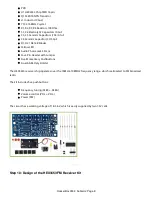
CC1101 Arduino ProMicro
------ ----------------
GND GND
VCC VCC (3.3V)
MOSI MOSI (16)
MISO MISO (14)
SCK SCLK (15)
GD02 A0 (18)
GD00 A1 (19)
CSN A10 (10)
A quick start for the CC1101 is to use the library from Elechouse. Download the library by clicking the "get code"
link on that page.
Create a folder for CC1101 in your Arduino Libraries folder. Place the two ELECHOUSE_CC1101 les (.cpp and .h) into
that folder. Also create an examples folder within that folder and place the three demo/example folders in there.
Update the pins de nitions in the le ELECHOUSE_CC1101.h like so:
#define SCK_PIN 15
#define MISO_PIN 14
#define MOSI_PIN 16
#define SS_PIN 10
#define GDO0 19
#define GDO2 18
Then place the example le CC1101_RX on one CCStick and the example le CC1101_TX on the second CCStick.
There are a number of other interesting resources and projects for the CC1101 transceiver including the following
example:
TomXue Arduino CC1101 Arduino Library
SmartRF Studio
Electrodragon CC1101 Project
CUL Project
CCManager Project
DIY nanoCUL
Another CC1101 Microcontroller Setup
NOT E ABOUT USING INT ERRUPT S:
NOT E ABOUT USING INT ERRUPT S:
To sample the Elechouse example sketch CC1101_RXinterruprt, connect two pins of the Arduino ProMicro on the
bottom side of the CCStick PCB. These are pins 7 and 19 (A1) which connects the transceiver GDO0 signal to pin 7 of
the microcontroller, which is one of the external interrupt pins. Next, update one of the pin de ne lines discussed
above to "#de ne GDO0 7 //and 19" since GDO0 is now jumpered from pin 19 to pin 7. Next, in the
CC1101_RXinterruprt le, nd the line calling function attachInterrupt() and change the rst parameter (interrupt
number) from "0" to "4". This is done because pin 7 of the ProMicro is associated with interrupt #4.
HackerBox 0034: SubGHz: Page 12

































